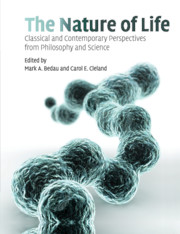Book contents
- Frontmatter
- Contents
- Preface
- Acknowledgments
- Sources
- About the authors
- Introduction
- SECTION I CLASSICAL DISCUSSIONS OF LIFE
- SECTION II THE ORIGIN AND EXTENT OF NATURAL LIFE
- 8 The origin of life: a review of facts and speculation
- 9 Small molecule interactions were central to the origin of life
- 10 Are the different hypotheses on the emergence of life as different as they seem?
- 11 The universal nature of biochemistry
- 12 Is there a common chemical model for life in the universe?
- 13 Searching for life in the universe: lessons from Earth
- 14 The possibility of alternative microbial life on Earth
- 15 Introduction to the limits of organic life in planetary systems
- SECTION III ARTIFICIAL LIFE AND SYNTHETIC BIOLOGY
- SECTION IV DEFINING AND EXPLAINING LIFE
- Supplementary bibliography on life
- Index
- References
12 - Is there a common chemical model for life in the universe?
Published online by Cambridge University Press: 10 November 2010
- Frontmatter
- Contents
- Preface
- Acknowledgments
- Sources
- About the authors
- Introduction
- SECTION I CLASSICAL DISCUSSIONS OF LIFE
- SECTION II THE ORIGIN AND EXTENT OF NATURAL LIFE
- 8 The origin of life: a review of facts and speculation
- 9 Small molecule interactions were central to the origin of life
- 10 Are the different hypotheses on the emergence of life as different as they seem?
- 11 The universal nature of biochemistry
- 12 Is there a common chemical model for life in the universe?
- 13 Searching for life in the universe: lessons from Earth
- 14 The possibility of alternative microbial life on Earth
- 15 Introduction to the limits of organic life in planetary systems
- SECTION III ARTIFICIAL LIFE AND SYNTHETIC BIOLOGY
- SECTION IV DEFINING AND EXPLAINING LIFE
- Supplementary bibliography on life
- Index
- References
Summary
INTRODUCTION
A simple “We don't know” is often the best answer for some questions, perhaps even for the title question, suggested by this issue's editors of Current Opinion in Chemical Biology. Because we have direct knowledge of life only on Earth, and as known life on Earth descended from a single ancestor, we have only one data point from which to extrapolate statements about the chemistry of life generally. Until life is encountered elsewhere, or aliens contact us, we will not have an independent second dataset. We may not even then, if the alien life itself shares an ancestor with life on Earth.
We can, of course, conceive of alternative chemical solutions to specific challenges presented to living systems. We can then test their plausibility by synthesizing, in the laboratory, unnatural organic molecules that represent the alternatives, and seeing if they behave suitably. Some of these alternatives come from simple “Why?” or “Why not?” questions. For example: why are 20 standard amino acids used in Terran proteins? Experiments with unnatural amino acids (using the natural ribosome to incorporate them into proteins) have expanded the amino acid repertoire of proteins. These experiments find no reason to exclude alternative sets of amino acids from hypothetical proteins in hypothetical alien life forms.
Similar questions can be asked about DNA. For example, why does Terran genetics use ribose and deoxyribose? Why not glycerol, a hexose or a tetrose? Again, synthetic chemists have made DNA analogs using each, and studied their behavior.
- Type
- Chapter
- Information
- The Nature of LifeClassical and Contemporary Perspectives from Philosophy and Science, pp. 164 - 185Publisher: Cambridge University PressPrint publication year: 2010
References
- 2
- Cited by

